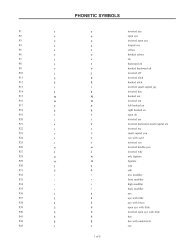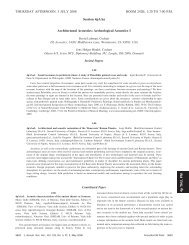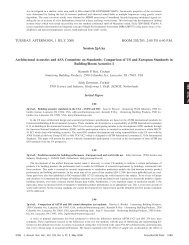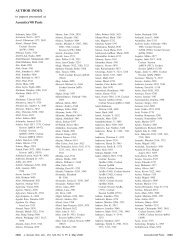Tuesday afternoon, 11 November - The Acoustical Society of America
Tuesday afternoon, 11 November - The Acoustical Society of America
Tuesday afternoon, 11 November - The Acoustical Society of America
You also want an ePaper? Increase the reach of your titles
YUMPU automatically turns print PDFs into web optimized ePapers that Google loves.
signals such as helicopters. This study compares computational auditory detection<br />
model predictions against a corresponding large sample <strong>of</strong> human<br />
sound jury data points obtained in the laboratory. Helicopter and ambient<br />
soundscape signals were obtained from high-sensitivity recordings in the<br />
field. Playback in the laboratory was achieved under high-fidelity headphones<br />
calibrated to accommodate helicopter primary rotor frequencies with<br />
minimal distortion above human sensation level. All listeners completed at<br />
least 12 000 trials detecting helicopters against rural and urban soundscapes<br />
to represent the spectrum <strong>of</strong> potential environments involved in a real world<br />
scenario. Analysis compares the human sound jury performance against a<br />
contemporary computational auditory detection model, called “AUDIB,” developed<br />
by the U.S. Army and NASA.<br />
4:30<br />
2pPP6. Simulating the precedence effect by means <strong>of</strong> autocorrelation.<br />
Jonas Braasch CA 3 RL, School <strong>of</strong> Architecture, Rensselaer Polytechnic<br />
Inst., Troy, NY 12180<br />
A number <strong>of</strong> algorithms have been developed to simulate the robust localization<br />
performance <strong>of</strong> humans in reverberant conditions, the most successful<br />
<strong>of</strong> which are based on contralateral inhibition. While these models<br />
can demonstrate the precedence effect in general, their nonlinear behavior<br />
makes it difficult to optimize their settings. A linear algorithm has now been<br />
developed to overcome this limitation. An autocorrelation algorithm determines<br />
the delay between lead and lag and their amplitude ratio for both<br />
channels. An inverse filter is then used to eliminate the lag signal before it is<br />
localized with a standard localization algorithm. Interestingly, the filter contains<br />
both inhibitory and excitatory elements, and the filter’s impulse response<br />
looks somewhat similar to the response <strong>of</strong> a chopper cell. <strong>The</strong> algorithm<br />
operates robustly on top <strong>of</strong> a model <strong>of</strong> the auditory periphery<br />
gammatone filterbank and halfwave rectification. Due to its linear nature,<br />
the model performs better if the full waveform is reconstructed by subtracting<br />
a delayed version <strong>of</strong> the halfwave-rectified signal, with a delay time that<br />
corresponds to half the period <strong>of</strong> each frequency band’s center frequency.<br />
<strong>The</strong> model is able to simulate a number <strong>of</strong> experiments with ongoing stimuli<br />
and performs robustly with onset-truncated and interaural-level-difference<br />
based stimuli.<br />
4:45<br />
2pPP7. Binaural loudness summation by cochlear implant users. Monika<br />
Kordus and Richard S. Tyler Dept. Otolaryngol.-Head Neck Surgery, Univ.<br />
<strong>of</strong> Iowa Hospital Clinics, 200 Hawkins Dr., Iowa City, IA 52246, monikakordus@uiowa.edu<br />
<strong>The</strong> loudness summation in people with bilateral and unilateral cochlear<br />
implants CIs was investigated. <strong>The</strong> stimuli were 1/3-octave bands <strong>of</strong> noise<br />
centered at frequencies <strong>of</strong> 0.25, 1, and 4 kHz presented frontally from a<br />
loudspeaker in an ascending or random sequence <strong>of</strong> level. Subjects rated different<br />
intensity levels between the threshold <strong>of</strong> hearing and level <strong>of</strong> discomfort<br />
on scales from 0 to 100. Eight intensity levels were used for normally<br />
hearing subjects who served as a control group. For the CI users, results<br />
showed difference in loudness between monaural and binaural conditions<br />
with substantial amount <strong>of</strong> binaural loudness summation. <strong>The</strong> shape <strong>of</strong> the<br />
intensity-loudness function varied between monaural and binaural conditions,<br />
depending on the listener. <strong>The</strong> power function <strong>of</strong> control group exhibited<br />
an exponent <strong>of</strong> near 0.5. In binaural condition, stimuli <strong>of</strong> the same<br />
sound pressure level were about 1.8 louder than in monaural condition. For<br />
0.25- and 4-kHz bands <strong>of</strong> noise, no consistent differences between monaural<br />
and binaural thresholds were observed. For a 1-kHz band, the binaural loudness<br />
ratings were about 3% and 9% lower for mid- or high-intensity levels<br />
as compared to the monaural condition. <strong>The</strong> results suggest future application<br />
for fitting bilateral devices. Work supported by NIH 5 P50 DC00242.<br />
TUESDAY AFTERNOON, <strong>11</strong> NOVEMBER 2008 LEGENDS 7, 1:30 TO 4:30 P.M.<br />
Session 2pSC<br />
Speech Communication: Prosody (Poster Session)<br />
Rahul Shrivastav, Chair<br />
Univ. <strong>of</strong> Florida, Comm. Sci. and Disorders, Dauer Hall, Gainesville, FL 326<strong>11</strong><br />
Contributed Papers<br />
All posters will be on display from 1:30 p.m. to 4:30 p.m. To allow contributors an opportunity to see other posters, contributors <strong>of</strong><br />
odd-numbered papers will be at their posters from 1:30 p.m. to 3:00 p.m. and contributors <strong>of</strong> even-numbers papers will be at their<br />
posters from 3:00 p.m. to 4:30 p.m.<br />
2pSC1. Passive exposure to speech stimuli facilitates within-category<br />
discrimination. Laurent Bonnasse-Gahot Ctr. d’Analyse et de Mathématique<br />
Sociales CAMS, UMR 8557 CNRS-EHESS, Ecole des Hautes<br />
Etudes en Sci. Sociales, 54 Bd. Raspail, Cedex 06, F-75270 Paris, France <br />
and Jessica Maye Northwestern Univ., Evanston, IL 60208<br />
Phonetic categories are known to induce good discrimination <strong>of</strong> stimuli<br />
from different categories and poor discrimination within category Liberman<br />
et al., J. Exp. Psych. 54, 358–368 1957. In addition, passive exposure to<br />
a phonetic continuum improves discrimination if stimuli are presented according<br />
to a bimodal distribution <strong>of</strong> occurrence frequency, whereas a unimodal<br />
frequency distribution results in decreased discriminability Maye et<br />
al., Dev. Sci. <strong>11</strong>, 122–134 2008. <strong>The</strong> present study examined whether passive<br />
exposure to bimodal versus unimodal frequency distributions results in<br />
a categorical pattern <strong>of</strong> perception. Stimuli were tokens <strong>of</strong> the syllable ma<br />
with rising pitch contour, where pitch slope varied across the continuum.<br />
Participants completed an AX discrimination task both before and after passive<br />
familiarization to either a unimodal or bimodal distribution <strong>of</strong> the con-<br />
tinuum stimuli. At post-test participants in the bimodal condition showed a<br />
significant improvement in discrimination and outperformed participants in<br />
the unimodal condition. However, contrary to the predictions <strong>of</strong> categorical<br />
perception, the bimodal group’s discrimination improved most for stimuli<br />
that did not cross the category’s boundary. <strong>The</strong>se data suggest that shortterm<br />
changes in speech perception after passive exposure may not reflect<br />
phonetic category learning but rather enhanced encoding <strong>of</strong> frequently occurring<br />
sounds.<br />
2pSC2. Temporal structure and syntactic disambiguation across lexical<br />
biases. Yoon-Shil Jeon, Amy J. Schafer, and Victoria B. Anderson Dept. <strong>of</strong><br />
Linguist., Univ. <strong>of</strong> Hawaii, 1890 East-West Rd., Honolulu, HI 96822,<br />
yoonshil@hawaii.edu<br />
<strong>The</strong> present study investigates prosodic cues across three lexical biases<br />
in the production <strong>of</strong> syntactically ambiguous sentences such as “Walkers and<br />
runners with dogs use the outer portion <strong>of</strong> the park,” in which “with dogs”<br />
can modify either the second conjunct alone low association or both conjuncts<br />
high association. A phrase-combination task induced speakers to<br />
2494 J. Acoust. Soc. Am., Vol. 124, No. 4, Pt. 2, October 2008 156th Meeting: <strong>Acoustical</strong> <strong>Society</strong> <strong>of</strong> <strong>America</strong><br />
2494







